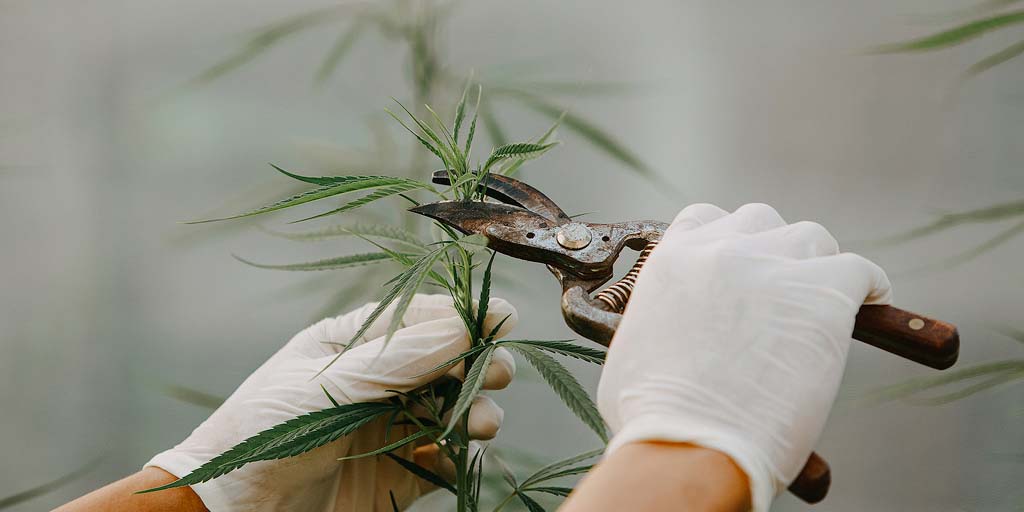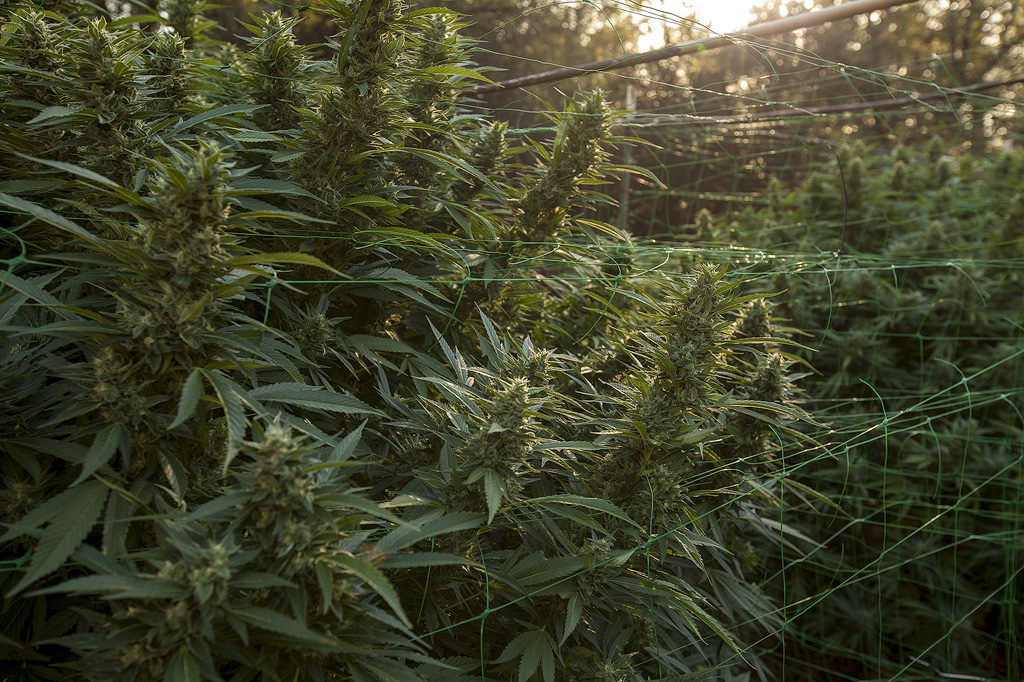
Do you want to increase the yield of your cannabis plants? Then consider fimming your cannabis plants. Fimming is an effective but risky method that, combined with techniques such as scrogging or using a trellis, optimizes the growth of your plants and can significantly increase the yield. In this article, we explain what fimming is, how to do it, and how to combine it with other cultivation techniques for the best results.
This method is rigorous, but it gives you a good understanding of the concept of fimming.
In this Article
What is Fimming?
Fimming, derived from "Fuck, I Missed" (a term that arose from a mistake during topping), is a cultivation technique where you do not completely cut off the top growth shoot of the cannabis plant, but only a part of it. This leads to the development of multiple new growth points instead of just two with regular topping. This results in a denser plant with more potential tops and thus a higher yield.
Why is topping cannabis perhaps better than fimming?
Your topping cannabis plants and fimming are both effective ways to manipulate the growth of cannabis plants and increase the yield, but they have some important differences.
You should not fim autoflowers due to their short growth period. Topping is more suitable.
With topping, you cut off the entire main top of the plant, resulting in two new growth points. This ensures better light distribution and stronger branches, but the number of new tops is limited to two.
Fimming, on the other hand, where you only cut off a part of the main top, creates three to four new growth points, leading to a more compact and fuller plant with more potential for a higher yield. Although fimming requires a bit more precision and the plant's recovery period may be a bit longer, it offers the possibility of a significantly larger yield, especially when combined with scrogging or trellising. Both techniques have their own advantages, and the best choice depends on your specific growing conditions and goals.

Why Fimming?
The main goal of fimming is to create more tops. With fimming, three to four new tops are created instead of two. This results in a more compact and wider plant, which is ideal for growers with limited space or those who want to maximize their yield.
Fimming offers the following advantages in cannabis cultivation:
-
Higher Yield: More tops mean more flowers and thus a higher yield.
-
Better Light Distribution: A wider plant ensures that more parts of the plant receive light, which promotes photosynthesis and growth.
-
Stronger Stems: Just like with topping, the plant develops thicker and stronger stems, making it better resistant to heavy tops and weather conditions.
How to Fim a Cannabis Plant
Fimming your cannabis plant is simple but requires a bit of precision. Follow these steps to do it correctly:
-
Choose the right time. Fim your cannabis plant when it has three to four nodes (branches). Do not do this too late, because after the second to third week of the flowering phase, the stress can actually reduce the yield.
-
Sterile scissors. Use clean, sterile scissors to prevent infections. A razor blade or a Stanley knife can also be used, but with the risk of cutting your fingers.
-
Cut the top. Instead of cutting off the entire top, cut about 75% of the top new growth. This means that you leave part of the new leaves.
Fimming and Scrogging
Scrogging, or Screen of Green, is a technique where you place a net or mesh above your plants to let them grow horizontally. This maximizes light absorption and creates a uniform canopy. Fimming and scrogging go hand in hand because fimming creates more tops, which can then be evenly distributed over the scrog net.

Fimming and Trellising
A trellis is a mesh panel or framework through which you can weave cannabis plants for extra support. By combining fimming with a trellis, you can support the plant while simultaneously creating more growth points.

Advantages of Fimming and Trellising:
-
Stronger plant. The trellis provides support for the extra tops created by fimming, preventing the plant from sagging under the weight.
-
More light. Just like with scrogging, a trellis ensures that the plant captures more light, leading to higher photosynthesis and better growth.
-
Better airflow. A trellis increases air circulation around the plant, which helps prevent mold and diseases.
Practical Tips for Successful Fimming
-
Start early. Begin fimming when your plant has three to four nodes. This is the ideal time to minimize stress and give the plant a chance to recover and develop new tops.
-
Combine techniques. Use fimming in combination with scrogging or trellising for the best results. These techniques complement each other and maximize the yield.
-
Give the plant time. After fimming, your plant needs some time to recover and develop new tops. Give it a week of rest before applying further training methods.
-
Keep checking. Ensure that the attachment points of the trellis or scrog net are regularly checked and adjusted. This prevents branches from getting pinched and ensures healthy growth.

This is a good time to fim for the first time. The young plant has enough nodes. Cut off three-quarters of the top growth shoot.
Pro tip from Dutch-Headshop: for a lush bloom after fimming, add a bloom stimulator like Big Bud to your bloom nutrients. This way, all those new branches will soon be full of beautiful resinous tops.
Frequently Asked Questions about Fimming
-
What is fimming? Fimming is a cultivation technique where you partially cut the top growth point of a cannabis plant to create multiple new tops.
-
How does fimming differ from topping? With topping, you cut off the entire main top, resulting in two new tops. With fimming, you only cut off part of the main top, resulting in three to four new tops.
-
When should I fim my cannabis plant? Fim your cannabis plant when it has three to four nodes (branches) and do this before the second to third week of the flowering phase.
-
What are the advantages of fimming? Fimming increases yield by creating more tops, improves light distribution, and results in a more compact, wider plant.
-
What are the disadvantages of fimming? Fimming can cause more stress than topping, which can lead to a longer recovery period for the plant.
-
Can I combine fimming with other cultivation techniques? Yes, fimming works well in combination with scrogging (Screen of Green) and using a trellis to further increase the yield.
-
How often can I fim a cannabis plant? You can fim a cannabis plant multiple times, as long as you give the plant enough time to recover between fimming sessions.
-
What do I need for fimming? You need clean, sterile scissors to partially cut the top growth point of the cannabis plant.
-
What should I do if I accidentally cut off too much of the top? If you accidentally cut off too much, you have probably topped the plant instead of fimming. This is not harmful, but you will get two new tops instead of three or four. You can learn from this.
-
How long does it take to see results after fimming? It usually takes a week for the plant to start developing new tops after fimming.
-
Is fimming suitable for all types of cannabis plants? Yes, fimming can be applied to both indica- and sativa-dominant plants, but autoflowers can be more sensitive to stress and require more caution.
-
Can I apply fimming to autoflowers? Although it is possible, fimming is not recommended for autoflowers due to their short life cycle and sensitivity to stress. They usually bloom earlier than the time to fim.
Now You!
Fimming is an excellent technique to increase the yield of your cannabis plants. By multiplying the number of tops, you create a denser and more productive plant. Combine fimming with scrogging or using a trellis for optimal results. With the right approach and care, you can enjoy an impressive harvest. Good luck and happy growing!